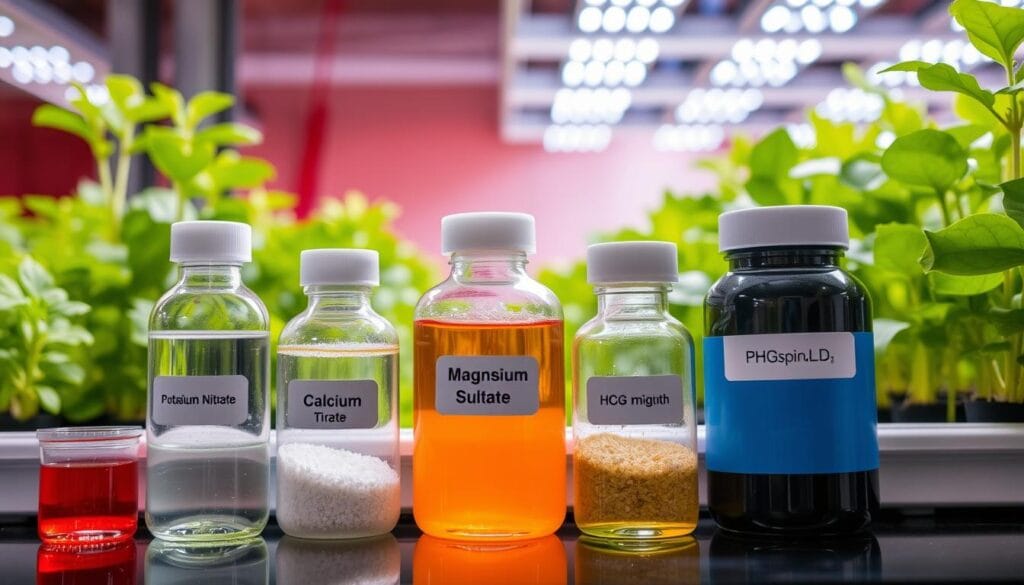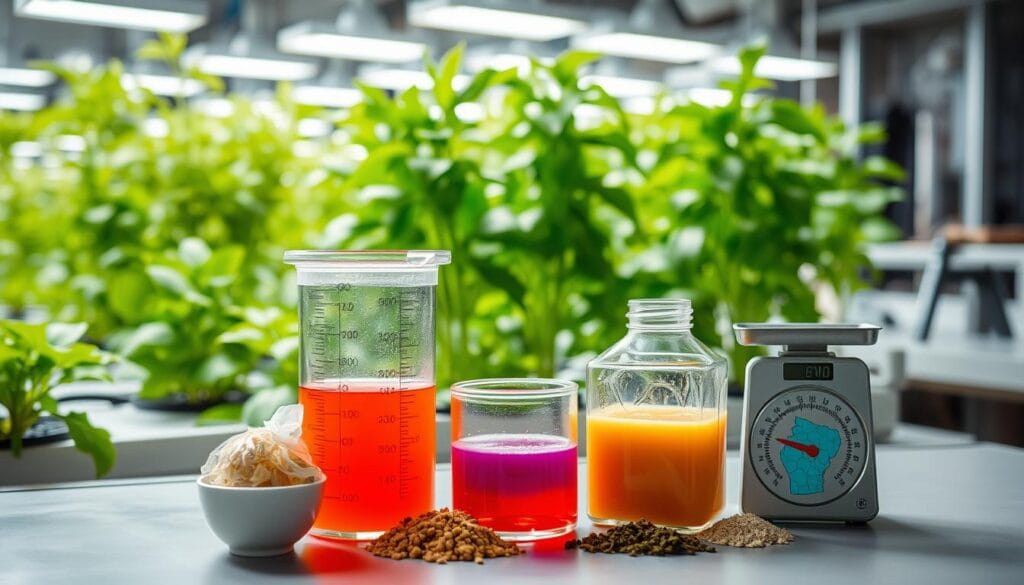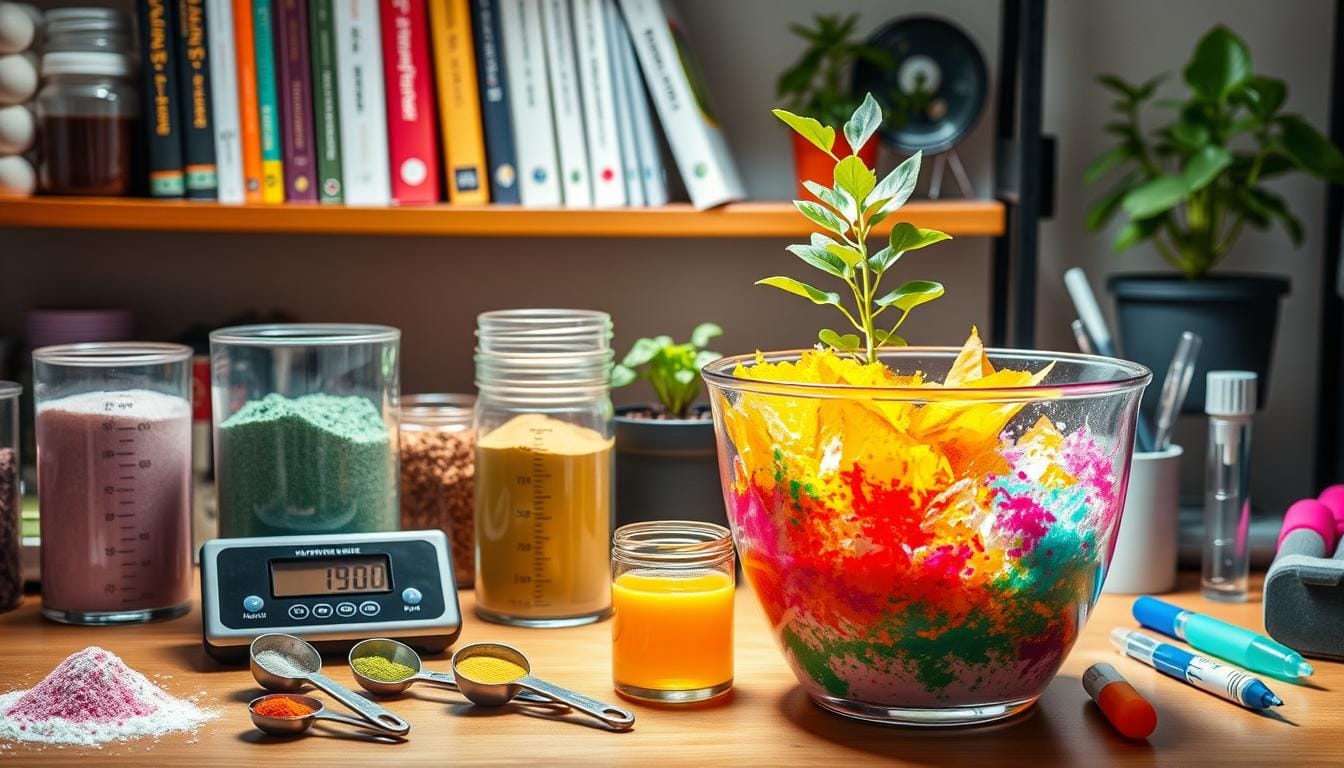DIY custom hydroponic fertilizers are the ultimate game-changer for modern plant enthusiasts. When I first stepped into my tiny urban apartment’s balcony garden, I quickly realized that traditional soil gardening wouldn’t cut it. My limited space demanded innovation, and these fertilizers became the perfect solution.
Creating custom nutrient solutions isn’t just a hobby – it’s a precise science. It empowers you to take complete control of your plant’s nutrition. With homemade hydroponic nutrients, you can customize every fertilizer drop to match your specific plant’s needs, saving money and optimizing growth in ways commercial products never could.
Hydroponic gardening represents a revolutionary approach to growing plants without soil. It uses nutrient-rich water solutions that deliver exactly what your plants crave. By mastering DIY hydroponic fertilizers, you’ll unlock a world of flexibility, precision, and sustainable growing.
Key Takeaways
- DIY hydroponic fertilizers offer unprecedented customization
- Creating custom nutrient solutions can significantly reduce gardening costs
- Precise nutrient management leads to healthier, faster-growing plants
- Understanding chemical components is key to successful hydroponic gardening
- Home-mixed fertilizers provide greater environmental control
Understanding Essential Nutrients for Hydroponic Growth
Mastering hydroponic nutrient requirements is key for growing plants well. Your plants need a mix of nutrients to grow and thrive.
Nutrients in hydroponics are divided into three main groups: macronutrients, secondary nutrients, and micronutrients. Each group is vital for plant health and growth.
Macronutrients: The Primary Nutrition Powerhouses
Macronutrients are the base of your plant’s diet. They include:
- Nitrogen (N): Drives leaf and stem development
- Phosphorus (P): Supports root growth and energy transfer
- Potassium (K): Enhances overall plant health and stress resistance
“Achieving the perfect balance of macronutrients can elevate your hydroponic garden from average to exceptional.”
Secondary Nutrients: Supporting Plant Development
Secondary nutrients are also key for strong plant growth:
- Calcium: Strengthens cell walls
- Magnesium: Critical for chlorophyll production
- Sulfur: Contributes to amino acid formation
Critical Micronutrients in Hydroponics
Micronutrients are needed in small amounts but are vital for plant health:
| Micronutrient | Primary Function |
|---|---|
| Iron | Chlorophyll synthesis |
| Manganese | Enzyme activation |
| Boron | Cell wall formation |
| Zinc | Growth hormone regulation |
Knowing about these nutrients helps you make perfectly balanced hydroponic solutions. This guarantees healthy plant growth and a bountiful harvest.
Benefits of Creating DIY Custom Hydroponic Fertilizers
Making your hydroponic fertilizers is a game-changer for gardeners and urban farmers. It lets you control the quality and cost of your nutrients. This is something commercial products can’t offer.
“DIY fertilizers unlock the full potential of your hydroponic garden, turning it into a unique, self-sustaining ecosystem.” – Hydroponic Expert
Here are the main benefits of DIY fertilizers:
- Complete nutrient customization for specific plant needs
- Significant cost savings through bulk ingredient purchasing
- Full control over ingredient quality and purity
- Flexibility to adjust nutrient concentrations
- Sustainable and environmentally conscious approach
DIY fertilizers offer more than just saving money. You can tailor nutrient mixes for each plant’s growth stage. This ensures your plants are healthy and grow well.
| Benefit Category | DIY Fertilizer Advantage |
|---|---|
| Cost Efficiency | Up to 50% cheaper than commercial solutions |
| Nutrient Precision | Customize NPK ratios for specific plant types |
| Quality Control | Select premium ingredients directly |
| Scalability | Easily adjust the mix for small or large gardens |
Creating your hydroponic nutrient mixes takes some learning and trial and error. But the benefits are worth it. Your plants will grow strong and produce well.
Essential Equipment and Materials for Mixing
Making effective hydroponic fertilizers needs the right tools and careful steps. Your success depends on picking the best hydroponic fertilizer equipment. Also, knowing how to use nutrient-mixing tools well is key.
Safety Equipment Requirements
Keeping safe while making nutrient solutions is very important. You’ll need important safety gear to avoid chemical harm:
- Chemical-resistant gloves
- Safety goggles
- Protective lab coat or apron
- Closed-toe shoes
- Respiratory mask (for fine powder handling)
Measuring Tools and Storage Containers
Getting the measurements right is key when mixing hydroponic nutrients. Invest in top-notch nutrient mixing tools for accurate mixes.
| Equipment Type | Recommended Material | Purpose |
|---|---|---|
| Measuring Cups | Food-grade Plastic | Precise Volume Measurement |
| Digital Scale | Stainless Steel | Weight Measurements |
| Storage Containers | Non-reactive Plastic | Nutrient Solution Storage |
Water Quality Testing Equipment
Testing water quality for hydroponics is vital for keeping nutrient solutions at their best. Key tools include:
- Digital pH meter
- Electrical conductivity (EC) meter
- Total dissolved solids (TDS) meter
- Water hardness test strips
“Precision in measurement defines the success of your hydroponic nutrient solution.” – Hydroponic Experts.
By choosing and using the right hydroponic fertilizer equipment, you’ll make nutrient solutions that help plants grow well. This will help you get the most out of your cultivation.
Basic Chemical Components for Nutrient Solutions
To make good hydroponic fertilizer, you need to know the key parts that help plants grow. Your DIY hydroponic setup needs the right mix of chemicals. These provide the minerals and trace elements plants need.

The main stuff for hydroponics includes several important chemicals. They give plants the balanced nutrition they need:
- Calcium Nitrate: Provides calcium and nitrogen
- Potassium Sulfate: Supplies critical potassium
- Epsom Salt (Magnesium Sulfate): Offers magnesium and sulfur
- Micronutrient Mixes: Delivers trace elements
Choosing the right parts for your nutrient solution means knowing about their chemical makeup. You also need to understand what plants need.
| Nutrient Type | Chemical Function | Recommended Concentration |
|---|---|---|
| Nitrogen (N) | Leaf and stem growth | 150-200 ppm |
| Phosphorus (P) | Root development | 30-50 ppm |
| Potassium (K) | Overall plant strength | 200-250 ppm |
“The secret to successful hydroponics lies in understanding the delicate balance of chemical nutrients.” – Hydroponic Expert.
When you’re looking for hydroponic fertilizer ingredients, find high-quality chemicals. Purity and solubility are key factors in creating an effective nutrient solution.
Understanding NPK Ratios and Plant Requirements
Learning about NPK ratios is key for growing plants in hydroponics. Nitrogen (N), Phosphorus (P), and Potassium (K) are the base of your fertilizer. How you mix these nutrients affects your plants’ health and growth.
Knowing what nutrients plants need at each stage is important. Each plant has its own nutritional needs at different times in its life.
Vegetative Stage Nutrient Needs
In the vegetative stage, plants need more nitrogen. This helps them grow leaves and stems fast.
- Nitrogen helps make chlorophyll
- It supports strong growth
- Good ratios are 3:1:2 or 10:5:5
Flowering Stage Requirements
When plants start flowering, their needs change. They need more phosphorus and potassium for flowers and fruits.
- Phosphorus helps with root growth and flower formation
- Potassium makes plants stronger
- Good ratios are 5:10:10 or 3:7:4
Customizing Solutions for Different Plants
Every plant is different and needs its nutrient mix. Leafy greens, fruiting vegetables, and herbs all have their own needs.
| Plant Type | Vegetative NPK Ratio | Flowering NPK Ratio |
|---|---|---|
| Leafy Greens | 10:5:5 | 5:7:5 |
| Tomatoes | 7:3:5 | 3:8:6 |
| Herbs | 6:4:4 | 4:6:5 |
Pro Tip: Always start with small nutrient solution batches and adjust based on plant response.
Managing nutrients in hydroponics is a learning process. Watch your plants closely and adjust your fertilizer as needed.
Step-by-Step Guide to Mixing DIY Custom Hydroponic Fertilizers
Making your hydroponic fertilizer needs precision and attention to detail. The DIY process might seem hard, but with the right steps, you’ll get it fast.

- Calcium nitrate
- Potassium sulfate
- Epsom salt
- Micronutrient blend
- Large mixing container
- pH testing kit
Follow these steps for mixing:
- Use warm water (not boiling) to help dissolve nutrients
- Start with calcium nitrate as your base solution
- Gradually add secondary nutrients
- Incorporate micronutrient blends carefully
- Stir thoroughly to ensure complete dissolution
“Precision in mixing is the key to successful hydroponic nutrient solutions.” – Hydroponic Experts.
It’s important to keep the NPK ratios and pH levels right. Most plants do best in a pH of 5.5 to 6.5. This helps them absorb nutrients better.
| Nutrient Type | Recommended Concentration | Purpose |
|---|---|---|
| Nitrogen (N) | 2-5% | Leaf and stem growth |
| Phosphorus (P) | 2-3% | Root and flower development |
| Potassium (K) | 4-6% | Overall plant health |
After mixing, keep your solution in an opaque container to avoid light damage. Always check and adjust the pH before using it. This ensures your plants get the best nutrition.
pH Management and Solution Balance
Successful hydroponic gardening needs precise nutrient solution stability and careful pH management. Your plants’ health depends on the perfect chemical environment. This requires strategic monitoring and adjustment techniques.
Hydroponic pH management is key for optimal nutrient absorption. Plants typically flourish in a pH range of 5.5 to 6.5. This is where essential nutrients are most accessible to their roots.
Testing and Adjusting pH Levels
Accurate pH measurement requires reliable testing methods. Here are some pH adjustment techniques for your hydroponic setup:
- Use digital pH meters for precise readings
- Employ liquid test kits as a budget-friendly alternative
- Keep calibration solutions on hand for equipment maintenance
Maintaining Nutrient Solution Stability
Nutrient solution stability is more than just pH control. Key factors include:
- Regular temperature monitoring
- Consistent aeration of nutrient solutions
- Periodic electrical conductivity (EC) checks
“Precision is the essence of hydroponic nutrient management” – Hydroponic Expert.
To adjust pH, use phosphoric acid to decrease levels or potassium hydroxide to increase them. Always make incremental changes to avoid shocking your plants.
Pro tip: Change your nutrient solution every 1-2 weeks to prevent nutrient imbalances and maintain optimal growing conditions.
Common Mistakes to Avoid When Making Fertilizers
Making DIY hydroponic fertilizers needs precision and attention. Mistakes in mixing nutrients can ruin your hydroponic project. Knowing common errors helps avoid crop failures.
Beginners in hydroponics face several challenges when making DIY fertilizers:
- Inaccurate measurement of chemical components
- Neglecting water quality testing
- Ignoring pH balance requirements
- Failing to adjust nutrient concentrations
Precision is key when mixing hydroponic nutrients. Small measurement errors can harm plant health and growth. Water quality is vital for nutrient solution effectiveness. City water often has chemicals that upset fertilizer balance, so filtration is key.
“In hydroponics, success and failure are often determined by just a few milliliters and pH adjustments.”
Key areas for troubleshooting DIY fertilizers include:
- Checking water source purity
- Verifying accurate nutrient ratios
- Monitoring plant response consistently
- Maintaining optimal pH between 5.5 and 6.5
Success in hydroponics depends on knowing these pitfalls. Regular testing, careful measurements, and adjusting your approach can help. This way, you can avoid common mistakes and grow strong plants.
Cost-Effective Sourcing of Raw Materials
Start saving money on hydroponic nutrients by using smart purchasing strategies. Your DIY fertilizer project can get cheaper if you know how to find the best deals on raw materials.
To cut costs on hydroponic nutrients, plan carefully and source smartly. The secret to cheap fertilizer ingredients is knowing where and how to buy them.
Bulk Purchasing Strategies
Here are some ways to save money through bulk purchasing:
- Join agricultural cooperatives for group discounts
- Research online wholesale suppliers specializing in hydroponic nutrients
- Compare prices across multiple reliable hydroponic suppliers
- Purchase larger quantities during seasonal sales
- Consider splitting bulk orders with fellow hydroponic enthusiasts
Reliable Supplier Selection
Finding the right supplier is key for quality nutrients. Look for vendors with:
- Proven track record in hydroponic supply
- Transparent ingredient sourcing
- Positive customer reviews
- Technical support and expertise
| Supplier Type | Pros | Potential Savings |
|---|---|---|
| Online Agricultural Retailers | Wide selection, competitive pricing | 10-25% |
| Local Agricultural Stores | Personal support, immediate availability | 5-15% |
| Hydroponic Specialty Shops | Expert advice, specialized products | 15-30% |
“Smart sourcing transforms your hydroponic nutrient costs from expensive to economical.” – Hydroponic Experts Network.
Pro tip: Always check product quality before buying large amounts of hydroponic nutrients.
Storage and Shelf Life Optimization
Storing hydroponic fertilizers right is key to keeping your nutrient solutions effective. To keep your DIY fertilizers fresh, use smart storage methods. This helps protect your investment and keeps your plants well-nourished.
“Storage isn’t just about putting containers away – it’s about preserving the nutritional value of your hydroponic solutions.” – Hydroponic Experts
The shelf life of your nutrient solution depends on a few important things:
- Temperature control (best between 45-85°F)
- Keeping it away from direct sunlight
- Using airtight, dark containers
- Managing humidity well
Dry soluble powder nutrients are great for storage. They can stay good for years if stored right. Here are some tips for storing them:
- Put dry ingredients in sealed, moisture-proof containers
- Store them in cool, dark spots
- Mark containers with the date you mixed them
- Use desiccant packets to stop moisture from getting in
Liquid nutrient solutions don’t last as long, from weeks to months. Check your nutrient levels and plant health often. This ensures your solutions keep working well.
Watch your stored hydroponic fertilizers for any signs of spoilage. Look for color changes, crystals, or strange smells. Storing them carefully can make your DIY nutrient solutions last longer.
Conclusion
Learning to make your hydroponic fertilizer changes how you garden. It lets you control exactly what your plants get. You can make special fertilizers for your plants’ needs.
This way of gardening saves money and helps your plants grow better. You can adjust the fertilizer for each stage of your plants’ lives. Keeping the right pH and checking the fertilizer’s strength helps your plants grow strong.
Hydroponic gardening is all about learning and trying new things. Every batch of fertilizer is a chance to get better and grow more. By being precise, you’ll grow healthier plants.
Working on your fertilizer helps your garden and the planet. As you get better, you’ll enjoy watching your plants thrive. You’ll feel proud of your green space.

